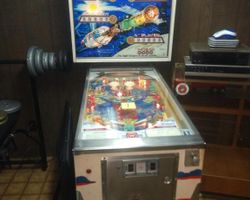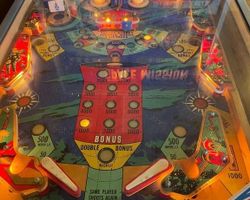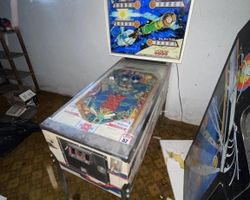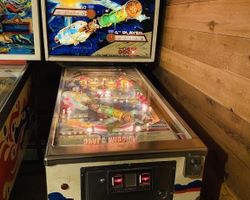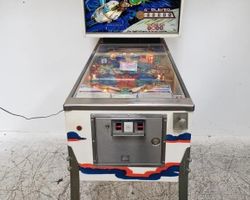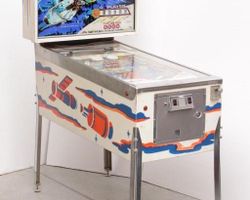Space Mission
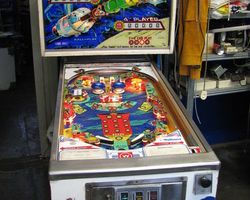
Average Prices: USD $300 to $800
Produced: January, 1976
Production Run: 11,652 units
Machine Type: Electro-mechanical
Players: 4
Design by: Steve Kordek
Art by: Christian Marche
In January 1976, Williams Electronics, Incorporated launched Space Mission, model number 464, an electro-mechanical (EM) pinball machine that invited players to embark on a cosmic adventure. Designed during the zenith of the space race and released shortly after the Apollo-Soyuz mission in 1975, Space Mission arrived as a thematic reflection of the era's fascination with outer space exploration. The machine, a 4-player iteration, shares its core gameplay with its 2-player sibling, Space Odyssey, also released in 1976.
The creative force behind Space Mission was Steve Kordek, credited with the design, concept, and mechanics of the game. Kordek, a prolific figure in pinball history, brought his expertise to bear on this title. The visually striking artwork was crafted by Christian Marche, whose artistic style contributed significantly to the machine’s allure. Marche's backglass art is particularly noteworthy, reportedly inspired by a NASA image which was in turn based on a painting by space artist Robert McCall. This connection to real-world space imagery grounded the game's theme in the contemporary cultural landscape.
Production of Space Mission commenced prior to January 5th, 1976, and continued through May 1976. An initial sample run of 206 units was followed by a main production run of 11,446 machines, resulting in a confirmed total production of 11,652 units. Interestingly, historical records suggest a small number, approximately 200 units, were manufactured with steel cabinets, a detail that adds a layer of intrigue for collectors. Priced at $861.50 for distributors with a bill of materials costing $355.99, Space Mission entered the market and found its place in arcades and homes, becoming a fixture of the electro-mechanical pinball era.
Signature Features and Design
Space Mission distinguishes itself through several key features that contribute to its unique gameplay and visual appeal. A prominent element is the centrally located swinging target. Unlike static targets, this dynamic component introduces an element of unpredictability and challenge, demanding precise timing and shot accuracy from players. Its movement adds visual interest to the playfield and alters shot trajectories, creating a more engaging and less predictable playing experience.
Another notable design choice is the placement of kick-out holes adjacent to the flippers. This configuration discourages players from cradling the ball for extended periods, a common tactic in pinball. Instead, it necessitates quicker reactions and more dynamic play, as errant balls near the flippers are more likely to be ejected back into play rather than being easily controlled. This feature contributes to the game's faster pace and heightened sense of risk.
Visually, Space Mission benefits from Christian Marche's artwork. The backglass vividly depicts a space scene, echoing the Cold War era's romanticized view of space exploration. The playfield artwork complements this theme, employing bright colors and stylized representations of celestial bodies and spacecraft, creating an immersive visual environment consistent with its space motif. While some variations in bumper cap colors (blue or white) exist, the overall aesthetic remains consistent, projecting a classic, vibrant electro-mechanical pinball aesthetic.
Playfield and Mechanics
The Space Mission playfield is designed for fast-paced, dynamic gameplay, typical of electro-mechanical machines of its era. It features a traditional two-flipper layout, controlling the lower portion of the playfield. Above the flippers, players encounter two pop bumpers, strategically positioned to create chaotic ball movement and scoring opportunities. Two kick-out holes, placed on either side of the flippers, present both a challenge and a means to reactivate the ball.
A central feature of the upper playfield is the swinging target. This target is often the focal point of gameplay, demanding accuracy to hit and contributing to bonus accumulation or special features. Adjacent to the swinging target is a spinner, another classic pinball element that rewards skillful shots with rapid point accumulation and a satisfying tactile and auditory feedback. Two standup targets are also incorporated into the playfield layout, offering additional scoring and objective-based opportunities.
The playfield artwork is integral to the game's theme. Brightly colored planets, stars, and rocket imagery adorn the play surface, reinforcing the space exploration concept. The lighting, typical of EM machines, uses incandescent bulbs to highlight key areas of the playfield and scoring elements. This combination of artwork and lighting creates a visually engaging play environment, drawing players into the game's thematic world. The overall flow of the playfield encourages players to utilize all areas, from the lower flippers to the upper playfield targets and spinner, promoting a varied and active playing style.
Gameplay Dynamics
Space Mission offers straightforward yet engaging gameplay typical of its electro-mechanical design. The primary objective is to score points by hitting various targets and features on the playfield. Scoring is tracked via mechanical reels, a hallmark of EM machines, which display scores up to 199,990 points per player. Players progress through the game by strategically aiming for pop bumpers, standup targets, the swinging target, and the spinner.
A key gameplay mechanic is the end-of-ball bonus. Accumulating bonus points during play adds an extra layer of strategy, as players aim to maximize their bonus multiplier before losing a ball. The spinner shot is particularly valued, offering substantial points and contributing significantly to the overall score. Successfully hitting the swinging target also plays a crucial role in accumulating bonus and advancing game objectives.
While Space Mission does not feature complex modes or multi-ball play common in later solid-state machines, its gameplay is centered around skillful shooting, precise timing, and bonus maximization. The kick-out holes near the flippers demand quick reflexes and prevent overly defensive play, encouraging a more dynamic and risk-taking approach. The game rewards accuracy and consistent play, with skilled players able to achieve high scores by mastering the spinner shot, swinging target, and bonus accumulation. The four-player capability enhances the social aspect, making it suitable for competitive play among friends and family.
Reception and Legacy
Space Mission has garnered a generally positive reception within the pinball community, appreciated for its distinctive features and nostalgic appeal. Players often commend its engaging gameplay flow, noting the fast-paced action encouraged by the kick-out holes and the challenge presented by the swinging target. The artwork, particularly on the backglass, is frequently praised for its beauty and thematic coherence, effectively capturing the spirit of the space exploration era. The classic sounds, characteristic of Williams EM games, further contribute to its nostalgic charm.
However, some players find the game challenging due to the kick-out holes, which can lead to quick ball drains and a perception of limited control. The ruleset, while functional, is relatively simple compared to more complex machines, which some perceive as lacking depth or potential for long-term engagement. The central swinging target, while unique, can occasionally lead to frustrating side drain situations. Some players also express a preference for drop targets, which are absent in Space Mission.
Despite these minor criticisms, Space Mission holds a valued place in pinball history. Its unique combination of features, including the swinging target and kick-out holes, sets it apart from many of its contemporaries. It exemplifies the electro-mechanical era of pinball, offering a direct and engaging gameplay experience focused on skill and timing. As a product of Williams and designed by Steve Kordek, with artwork by Christian Marche, Space Mission remains a fondly remembered title, representing a significant period in pinball design and reflecting the cultural zeitgeist of the 1970s space race.
 Active Auctions
Active Auctions
 Auction Results
Auction Results
| Cost | Location | Date |
|---|---|---|
| USD $850 |  Maryland, United States Maryland, United States |
31 January, 2025 |
| EUR €1,500 |  Nordrhein-Westfalen, Germany Nordrhein-Westfalen, Germany |
11 November, 2024 |
| USD $1,350 |  Virginia, United States Virginia, United States |
04 September, 2024 |
| USD $1,450 |  New York, United States New York, United States |
31 May, 2024 |
| USD $500 |  Wisconsin, United States Wisconsin, United States |
09 May, 2024 |
| USD $800 |  United States United States |
24 February, 2024 |
| GBP £950 |  United Kingdom United Kingdom |
21 July, 2023 |
| AUD $2,600 |  Victoria, Australia Victoria, Australia |
02 July, 2023 |
| USD $2,500 |  New York, United States New York, United States |
27 June, 2023 |
| EUR €550 |  Italy Italy |
01 June, 2023 |


Private Policy · Search Website · Contact Us
All trademarks and copyrighted materials remain property of their respective owners.
All other content copyright 2007 - 2025 Pinpedia.

